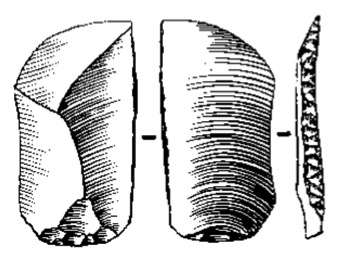
"Normal abrupt retouch. This is retouch, only slightly or not at all scaled, where the removals form a neat right angle with the ventral surface and clearly reduce the width of the piece, thus squarely removing the cutting edge of the edge or edges it occupies, forming a 'back'" (Tixier 1974, 20).
"Abrupt retouch on an anvil. This is abrupt retouch where the removals start from both surfaces of the piece and form a back. ...it appears that (a piece was) placed on an anvil then retouched all along the edge, the removals made by the counterblows of the anvil only beginning at the point where the piece comes in contact with the anvil..." (Tixier 1974, 21). This form of application is often characterized by crushing along the surface of contact with the anvil.
Abrupt retouch completely removes the original cutting edge of a blank. When this is applied to a lateral edge it is called backing; if applied to a lateral edge it is called backing; if applied to the distal end the piece is considered to be truncated flake or a truncated blade Truncation can be an end in itself or a means to further production. Due to the steep angle to the ventral surface formed by this application this type of retouch is normally used for shaping and blunting rather than for sharpening a blank. See Brézillon 1977, fig. 20, h and i; and 108, 110, 115, 118-122.